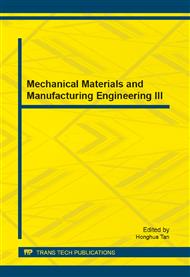p.159
p.163
p.167
p.173
p.179
p.185
p.193
p.198
p.202
Effect of Heat Treatment on the Microstructure and Hardness f X38CrMo16 Steel
Abstract:
Effect of quenching-tempering process on microstructure and hardness of X38CrMo16 steel was investigated by means of OM, SEM, XRD and a digital hardness tester. The quenched and tempered steel consists of martensite (or its tempered structure), δ-ferrite and secondary particles. The secondary particles are identified as a FeCr intermetallic phase based on EDS and XRD analysis. Along with the increase of quenching temperature, the quantity of secondary particles gradually decreases and the prior austenite grains grow significantly, which led to the coarsening of martensite. A large number of blocky ferrite formed due to the increase of chromium level in the matrix. In addition, the hardness of the quenched steel continuously increases with quenching temperature up to 1100°C and then drop observably. Hence, the suitable quenching temperature of the steel is between 1050 and 1100°C. After tempering at 200 and 300°C, the hardness of the steel decreased due to the formation of tempered martensite and increased slightly after tempering at 400°C owing to secondary hardening, whereas this value decreased again after tempering at 500 and 600°C due to the formation of tempered sorbite.
Info:
Periodical:
Pages:
179-184
Citation:
Online since:
November 2013
Authors:
Keywords:
Price:
Сopyright:
© 2014 Trans Tech Publications Ltd. All Rights Reserved
Share:
Citation:


